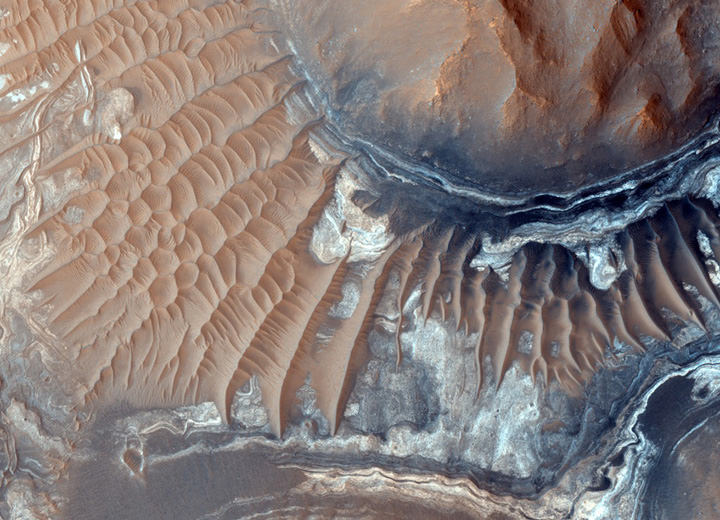[/caption]
Although it might seem like a fictitious nomenclature, smectite is a real substance and it’s been found on Mars. It’s a clay mineral that, like a sponge, expands and contracts as it takes on liquid water. With magnesium, iron, aluminum and silica in their content, smectites are morphed into being when silicates are exposed to non-acid water. Now Mars has yielded up two such deposits that further indicate the presence of a once wetter world.
“We discovered locations at Noctis Labyrinthus that show many kinds of minerals that formed by water activity,” said Catherine Weitz, lead author and senior scientist at the Planetary Science Institute. “The clays we found, called iron/magnesium (Fe/Mg)-smectites, are much younger at Noctis Labyrinthus relative to those found in the ancient rocks on Mars, which indicates a different water environment in these depressions relative to what was happening elsewhere on Mars.”
Thanks to high-resolution images from the High Resolution Imaging Science Experiment (HiRISE) camera and hyperspectral data from the Compact Reconnaissance Imaging Spectrometer for Mars (CRISM) on the Mars Reconnaissance Orbiter (MRO) spacecraft, combined with Digital Terrain Models (DTMs), Weitz and her team observed about 300 meters of escarpment restricted to two 30 to 40 kilometer troughs located at the western edge of the Vallis Marineris canyon. By studying the “geological layers” the team was able to map hydrated minerals and better understand how the water chemistry evolved.
“These clays formed from persistent water in neutral to basic conditions around 2 to 3 billion years ago, indicating these two troughs are unique and could have been a more habitable region on Mars at a time when drier conditions dominated the surface,” said co-author and CRISM team member Janice Bishop from the SETI Institute and NASA AMES Research Center.
The huge troughs reveal a rich geological chronicle of events. Like reading a book, each layer is a chapter in Martian water history. As they would fill, they would take on a chemical signature of that era. Then the troughs would erode and nearby volcanism added its own particular brands. Again, they would fill and chemicals would mix. Even the pH levels of the water adds its own fingerprint to the smectite equation. While it isn’t a unique find, what sets this area apart is that things appear to have happened in a reverse order as opposed to what happened globally across Mars. As exciting as these new finds are, for now studies will have to remain photographic.
“These troughs would be fantastic places to send a rover, but unfortunately the rugged terrain makes it unsafe both for landing and for driving,” Weitz said.
Original Story Source: Planetary Science Institute Press Release.

